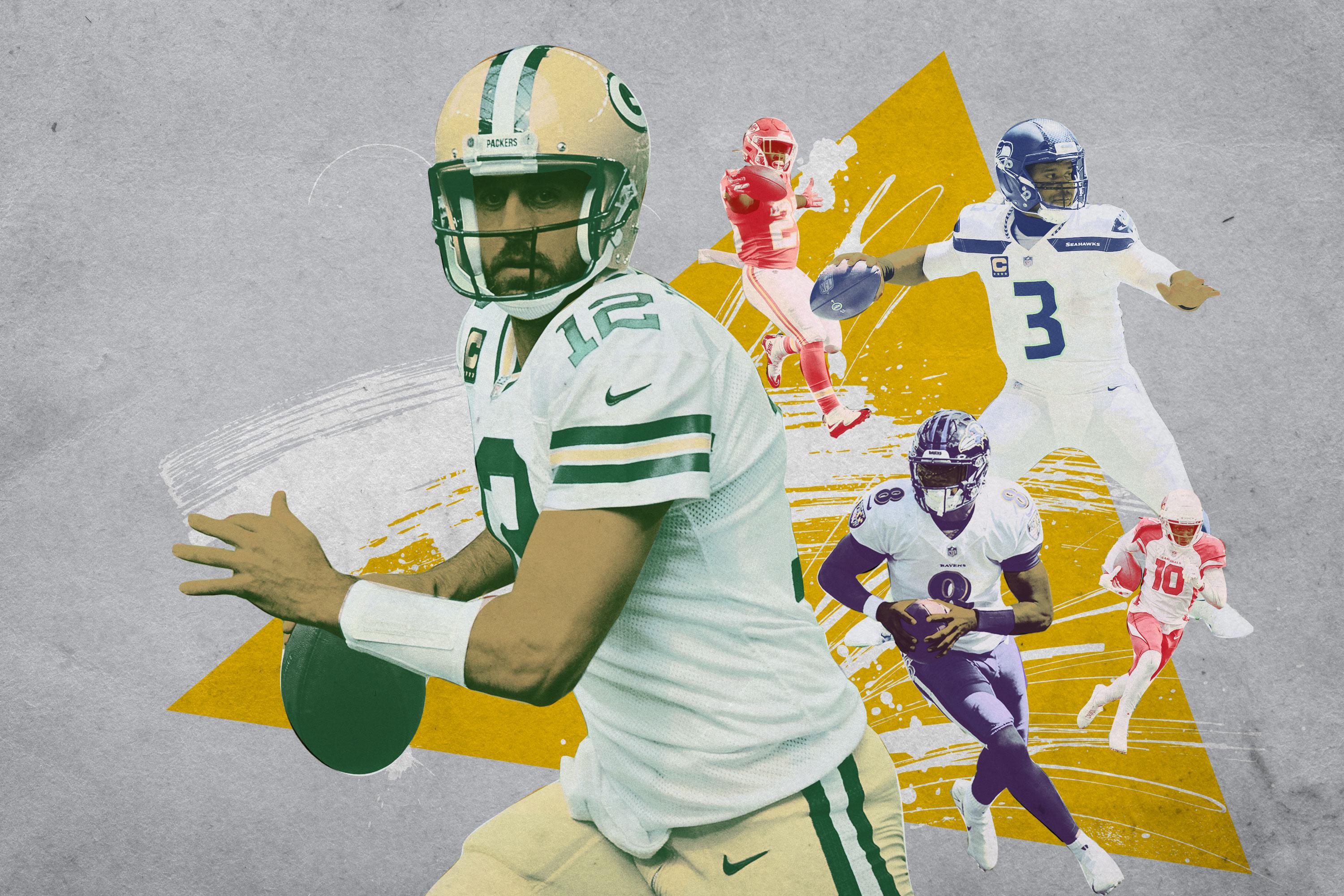
The NFL’s Week 1 slate was about as delightfully weird as I thought it’d be, a mostly fanless, at-times sloppy affair that gave us our first in-game looks at Tom Brady in a Buccaneers uniform, Cam Newton in Patriots garb, and Philip Rivers in Colts blue and white. It was fun as hell from start to finish and produced an overwhelming onslaught of action that felt a little like drinking from a fire hose after enduring the bizarre, no-preseason summer. So, where do the league’s 32 teams stand following the opening week of games? Well …
It’s important to not overreact to what we saw in Week 1, but we can’t ignore what went down, either. With that in mind, here are my updated NFL Power Rankings after a chaotic and wacky Week 1 in the NFL.
The Top Shelf
1. Kansas City Chiefs (1-0)
2. Baltimore Ravens (1-0)
3. New Orleans Saints (1-0)
4. Seattle Seahawks (1-0)
5. Pittsburgh Steelers (1-0)
The Chiefs and Seahawks’ Freaky Friday–Style Swap
The Chiefs didn’t have much trouble dispatching an overmatched Texans squad 34-20 on Thursday Night Football. But while the defending champs seemed to pick up where they’d left off last season, the way they dominated the game felt a whole lot different from what we’ve gotten used to in the Patrick Mahomes era. For starters, Mahomes was far less aggressive throwing the ball downfield than normal, attempting just one pass of 20-plus yards in the game (just the second time in his career he’s failed to throw deep more than once) while relying primarily on quick-hitting underneath passes. Even stranger, Kansas City scaled back its typically audacious pass-first philosophy and went with a more balanced approach, dialing up more run plays (34) than called pass plays (33) in the win―something Andy Reid did exactly zero times in the team’s 19 games last year.
Kansas City’s offense in 2019 was built around its all-out aerial attack. That unit was far more pass-happy than any other team last year, dialing up throws on 64 percent of its early-down, non-fourth-quarter plays (I excluded third downs and fourth-quarter plays because in those situations, play-calling is more dictated by down, distance, and score than overall philosophy). Reid called passes on just 50 percent of those situations against the Texans (22 of 44 plays) on Thursday, a rate that would’ve ranked 11th lowest in 2019. Is this a new, run-heavy era for Mahomes’s Chiefs or an opponent-specific, abbreviated-offseason outlier? I’m guessing the latter, but it’s something to keep an eye on next week.
In an ironic twist, the Seahawks apparently took Russell Wilson’s offseason lobbying for a Chiefs-styled approach to heart. Seattle ditched its signature run-establishing ethos in a 38-25 win against the Falcons and mercifully Let Russ Cook to open the season with an uncharacteristic pass-first tack, particularly on early downs. Ten of Wilson’s first 13 snaps were called passes, and by the end of the third quarter he’d dropped back to pass on 25 of the team’s 37 early-down plays. That’s a 68 percent pass rate on early-down, non-fourth-quarter plays, a rate that would’ve even outpaced last year’s Chiefs. That game plan came in stark contrast to Seattle’s 48 percent pass rate in those situations last year, which was tied for 26th leaguewide. The idea behind this potential sea change is that instead of playing everything close to the vest for the first three quarters and then asking Wilson to bail the team out late in the game (as we saw for much of last year), Seattle wants to do what the Chiefs have done under Mahomes: build an early lead and then protect it.
And that’s exactly what happened on Sunday. The Seahawks’ uncharacteristic aggressiveness on fourth down was also a pivotal factor. As the Football Outsiders Almanac notes, Seattle had gone for it on fourth down a league-low 10 percent of the time since 2015, a product of Pete Carroll’s increasingly conservative approach. Well, Carroll slipped into the long-stifled alter ego from his USC days, conjuring Big Balls Pete on a critical fourth-and-5 play from the Falcons’ 38-yard line midway through the third quarter. Instead of punting it and hoping to play the field position game, as we’ve seen the Seahawks do so many times in the past few years, Carroll let Wilson do his thing. The 31-year-old quarterback surveyed the defense and slung a precision pass down the sideline to DK Metcalf for a touchdown.
Seattle never looked back from there. They built a 31-12 lead early in the fourth quarter and coasted the rest of the way. It was an impressive win for the Seahawks and an important statement from the team, which, at least for one game, took the restrictor plate off Wilson’s power. We’ll see whether Seattle follows the same strategy against a much tougher Patriots defense next week.
Oh, and as for the Seahawks defense―that unit gave up a lot of yards playing a lot of soft coverage later in the game, but Jamal Adams looked like a true game-changer.
Adams racked up 12 tackles and notched a sack, two QB hits, and a hurry on 11 pass-rush snaps. I’ll admit to some sticker shock when the Seahawks decided to give up two first-round picks for the former Jet, but he was everywhere in his first game for his new team.
The Ravens Offense Is Still a Buzz Saw
Discussions around Lamar Jackson’s outlook for this season have typically come with requisite caveats for expected impending regression. Jackson’s performance in 2019 was awesome, but it was also an incredible outlier—he not only set a record for QB rushing yards (1,206), but paced the league in both touchdown passes (36) and touchdown rate (9 percent), the latter of which, as history tells us, is almost sure to decline in 2020.
But as I wrote last week, the league has never really seen a quarterback quite like Jackson. And if his Week 1 performance told us anything, it’s that he’s the exact type of player who could set a new precedent. Jackson calmly picked apart a hapless Browns defense, completing 20 of 25 passes for 275 yards and three scores while compiling a near-perfect 152.1 passer rating. The reigning MVP notched a 12 percent touchdown rate in the team’s opener, for those keeping track at home, and his raw numbers don’t even tell the full story for just how in command he was all game. Jackson completed a career-best 9-of-10 passes for 180 yards on throws 10-plus yards downfield and coolly alternated between lofted touch passes and sidearm throws. He also added 45 yards on the ground on seven carries.
Jackson―and the Ravens offense at large―showed us that they’ve got a few new cards to play in 2020. The team’s top pass-catching duo in particular look ready for liftoff to a whole new stratosphere: After being limited to a 41 percent snap rate in 2019, tight end Mark Andrews played a more robust role in Week 1, reeling in five catches for 58 yards and two touchdowns―one of which was a spectacular one-handed grab on one of Jackson’s few errant throws. In this offense, which funnels so many targets to the middle of the field and to the tight end position, Andrews’s ceiling feels limitless. Meanwhile, second-year receiver Marquise Brown (who played in just half of the team’s snaps as a rookie) netted a five-catch, 101-yard line (all of which came in the first half), a clear signal that he’s ready to put his injury-shortened rookie season in the rearview and make a big leap in 2020. It didn’t hurt either that rookie running back J.K. Dobbins flashed in relief of Mark Ingram, and Dobbins found the end zone twice on just seven carries.
All told, the Ravens’ offense looked just as good as, if not better than, the juggernaut group we saw last year. The main difference could be Jackson’s ongoing development as a passer. As NFL.com’s Gregg Rosenthal pointed out, Baltimore’s 107 yards on the ground represents the low mark of the Jackson era. The Ravens still scored 38 points.
The Contenders
6. Green Bay Packers (1-0)
7. Tennessee Titans (1-0)
8. Buffalo Bills (1-0)
9. Los Angeles Rams (1-0)
10. New England Patriots (1-0)
11. Tampa Bay Buccaneers (0-1)
12. Dallas Cowboys (0-1)
13. Arizona Cardinals (1-0)
14. San Francisco 49ers (0-1)
The Aaron Rodgers Spite Tour Begins
In the Packers’ 43-34 win over the Vikings, Rodgers threw up a proverbial middle finger at a few offseason narratives. Primary among them was the idea that Green Bay’s actions over the past few months have signaled a desire for a more conservative, run-first offense that would, at best, mitigate Rodgers’s impact on games, and at worst, push him out of the city altogether. After all, the Packers had traded up in the first round of the draft to take its developmental quarterback of the future in Jordan Love, used its second-rounder on a bruising, between-the-tackles running back in AJ Dillon, and picked tight end/full back hybrid Josiah Deguara in the third round―all while almost completely neglecting the team’s clear needs at receiver. It was all enough to make Rodgers pour himself a healthy glass of tequila.
As it turns out, we’ll have to wait at least another week to see whether the Packers will neuter their future Hall of Fame quarterback. Rodgers put on a vintage performance in the team’s opener, connecting on 32 of 44 passes for 364 yards and four touchdowns. The 36-year-old did pretty much whatever he wanted in the dominant win (it wasn’t as close as the final score indicated), averaging 8.3 yards per attempt while effortlessly running the team’s offense. Rodgers said after the game that he was able to tap into “that flow state” right from the start―I’m picturing something like Neo realizing he can read the Matrix―and the results pretty much spoke for themselves. Green Bay scored on all but two of its nine drives (not counting kneeldowns to end the game), racked up 522 yards of offense, and held the ball for 41 minutes and change. For the most part, Rodgers acted as the point guard within the structure of the offense, feeding the football to Davante Adams (14 catches, 156 yards, and two touchdowns) while showing off some chemistry with Marquez Valdes-Scantling (four catches, 96 yards, one TD) and third-year pro Allen Lazard (four catches, 63 yards, one TD).
And, in typical Rodgers fashion, he produced a few of his signature sandlot plays too. On a second-and-9 from the Vikings’ 24-yard line, Rodgers stepped up into the pocket, sprinted out to his right, and whipped a dime to Adams in the front corner of the end zone.
This play early in the fourth quarter, another roll-out by Rodgers, all but sealed the deal for Green Bay. Rodgers drifted to his right and slung a side-arm dart to Lazard, giving the team a commanding 36-18 lead.
It sure felt like Rodgers was making a statement with the near-perfect performance. I hope it’s a sign of things to come; the NFL is just more fun when Rodgers goes full fire-breathing dragon on his opponents. As Adams told The Athletic’s Matt Schneidman after the game, the veteran quarterback seems to be on a mission this year. “He’s always extremely focused,” said Adams, “but there’s a certain type of look in his eye he has, and he had that going into the week.”
The Cardinals Look Ready to Create Some Chaos
Arizona’s Week 1 upset over the defending NFC champion 49ers was impressive enough on its own merit, and Kyler Murray’s R.C. car acceleration as a runner is beautiful to behold (Murray scampered for 91 yards and a score on 13 carries). But what stuck out to me about that game was just how much meat the Cardinals left on the bone in their tough divisional win on the road.
Murray’s instant connection with DeAndre Hopkins (he caught a career-high 14 passes for 151 yards) is a huge plus and should give Murray a massive boost all year, but as we saw on Sunday, the second-year passer is still just scratching the surface of what he can do in Kliff Kingsbury’s offense. Murray finished 26-of-40 for 230 yards with one touchdown and one interception, but a glimpse of his passing chart shows a lot quick-hitting throws inside 10 yards.
This quick-release plan was probably smart against San Francisco’s dominant pass-rushing front, but Arizona is typically aggressive downfield. Murray, who was the league’s most accurate deep-ball passer last year, completed just five passes farther than 10 yards and none more than 20 yards in the win.
The Cardinals were also plagued by penalties (nine for 102 yards) in the game and it didn’t help that kicker Zane Gonzalez missed a pair of field goals (from 49 and 52 yards). If Arizona can clean up a few procedural mistakes, get some consistency from its kicking game, and, most importantly, unlock the downfield passing game we saw so many flashes of last season, this Cardinals team has a real shot to make some noise in a wide-open NFC West.
The Muddled Middle
15. Chicago Bears (1-0)
16. Indianapolis Colts (0-1)
17. Minnesota Vikings (0-1)
18. Philadelphia Eagles (0-1)
19. Houston Texans (0-1)
20. Atlanta Falcons (0-1)
21. Los Angeles Chargers (1-0)
22. Las Vegas Raiders (1-0)
23. Denver Broncos (0-1)
24. Detroit Lions (0-1)
25. Washington Football Team (1-0)
Washington’s Front Line Gives Them a Chance
Look, I’m definitely not saying the Washington Football Team is Super Bowl bound, but Ron Rivera’s surprisingly plucky squad does bear a few similarities to the 2019 49ers. Just bear with me: After a disastrous 4-12 season in 2018, San Francisco turned around and drafted a dominant, game-ready pass rusher out of Ohio State with the no. 2 pick (in this case, Nick Bosa). Bosa proved to be the keystone piece for an already-talented defensive line, a group that regularly controlled games from start to finish during the team’s Super Bowl run. San Francisco’s offense under an innovative and creative play-caller in Kyle Shanahan certainly carried its weight as well, particularly the dominant rushing attack.
Now let’s do Washington: After a disastrous 3-13 season in 2019, Washington turned around and drafted a dominant, game-ready pass rusher out of Ohio State with the no. 2 pick (in this case, Chase Young). We’re operating on early returns only, but Young sure looks a lot like the keystone piece for an already-talented defensive line, a group that has quickly shown the ability to control games from start to finish.
Now, Scott Turner has a long way to go if he hopes to build something that can even come close to mimicking what Shanahan’s offense did last year, but Rivera’s defense―at least based on its Week 1 performance―looks really good. Washington racked up eight sacks in its surprising 27-17 win over the Eagles, overwhelming an injury-riddled Philly line while hitting Carson Wentz 14 times and helping to force three backbreaking turnovers (two Wentz interceptions and a lost fumble). Overall, that defensive group held Philadelphia to a measly 4.0 yards per play and put the clamps down after the Eagles jumped out to an early 17-0 lead―providing the team’s young offense under Dwayne Haskins the opportunity to mount a 27-0 run over the final three quarters.
Washington is likely still at least a year away from serious contention, but this dominant, tone-setting defensive line is going to make them tough to deal with week in and week out.
And the Rest
26. Jacksonville Jaguars (1-0)
27. Cleveland Browns (0-1)
28. New York Giants (0-1)
29. Miami Dolphins (0-1)
30. Cincinnati Bengals (0-1)
31. Carolina Panthers (0-1)
32. New York Jets (0-1)
Minshew Mania Is Alive and Well
The Jaguars spent the offseason off-loading the remaining core pieces of the team that made it to the 2018 AFC championship game, a series of salary dumps and trades that kicked off a total rebuild—and, perhaps, a leading role in the Trevor Lawrence sweepstakes. All those maneuvers distracted from one obvious and inevitable fact, though: Minshew Mania cannot be stopped.
Gardner Minshew II silenced the Tank for Trevor narratives at least for one week, completing an absurd 19 of 20 passes for 173 yards and three touchdowns in the team’s 27-20 win over the Colts. Minshew calmly distributed the ball to receivers DJ Chark (three catches, 25 yards, and one touchdown), Keelan Cole (five catches, 47 yards, one TD), and rookie Laviska Shenault Jr. (three catches, 37 yards, and one touchdown), and rookie running back James Robinson flashed in his opportunities on the ground. This Jacksonville offense is young and inexperienced, but with a confident passer in Minshew under center, it’s clearly better than we’ve been giving it credit for all offseason. The Jags defense showed some signs of life in the win, too, particularly rookie corner C.J. Henderson (one pick and three passes defensed). Jacksonville came in at no. 32 in my preseason Power Rankings, but I’m not sleeping on this team anymore.

